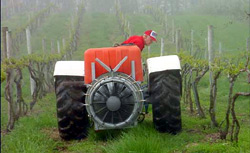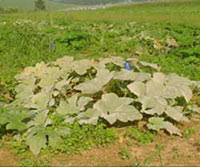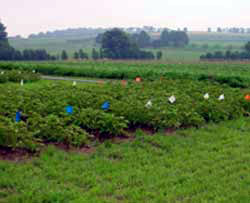|
Compost tea research
enters its second year
By Laura Sayre
Study aims to shed light on current debates over the safety
and efficacy of compost tea as an organic material
 Spraying
his way: Collaborating farmer Steve Wright applying compost
tea in his Pennsylvania vineyard. Spraying
his way: Collaborating farmer Steve Wright applying compost
tea in his Pennsylvania vineyard.
Is compost tea the new compost?
The use of compost teas--liquid fertilizers made by soaking
compost in water--is probably almost as old as the use of
compost itself. In recent years, however, a new generation of
farmers has begun reporting dramatic results from using
compost teas to boost plant health and help manage plant
pathogens. Scientists have been seeking to identify the
constituent microorganisms and nutrients present in compost
teas and to explain how and why they impact agroecosystems.
Entrepreneurs have been busily inventing and marketing new
contraptions for brewing the stuff. And last but not least,
the National Organic Program (NOP) is struggling to develop
official language to regulate its use in organic production.
Sound familiar?
Compost went through--and indeed, is still going through--a
similar process, from traditional input to subject of
scientific investigation. A growing number of peer-reviewed
research articles have reported on compost's
disease-suppressive qualities, but its use continues to be
attacked in the mainstream media as a potential source of
bacterial contamination in food. And while the NOP regulatory
text now defines compost and specifies the conditions of its
use, opinions differ about the proper application and
underlying logic of those rules.
The Rodale Institute™ has been a leading advocate of
composting for decades, testing different farm- and
garden-scale composting systems, evaluating the practicality
and nutrient profile of a variety of types of composts, and
sharing the results through field days and publications. So
it's not surprising that researchers here have also gotten
interested in compost tea.
In the spring of 2003, The Rodale Institute (TRI) and
Pennsylvania State University launched a two-year study funded
by a grant from the Northeast Sustainable Agriculture Research
and Education program (NE SARE). Lead TRI investigators Matt
Ryan and Dave Wilson explain that the goals of the project are
twofold: to gather hard data on the compost tea's
effectiveness for stimulating plant growth and suppressing
disease, and to educate farmers and extension agents about its
potential benefits--and hazards--as an organic material.
"There's a lot of excitement right now about compost tea--more
and more growers are using it, and there's a lot of anecdotal
evidence about its ability to suppress plant diseases," says
Ryan. "But there's a real lack of independent scientific
evidence. Our hope is to start filling that void."
It's all in how you brew it
Compost tea can be 'brewed' according to two basic methods:
passive and active, or aerated. Making passive compost tea is
a low-tech proposition requiring nothing more than a barrel, a
mesh bag, compost and water. You put the compost in the bag,
submerge the bag in the barrel of water (TRI researchers
suggest a ratio of 1 part compost to 5 parts water), wait a
week or two, and you have your tea.
 Grape
grower Phil Roth has been a pioneer in the use of composts for
fertility and soil improvement in vineyards. Grape
grower Phil Roth has been a pioneer in the use of composts for
fertility and soil improvement in vineyards.
Aerated compost tea is a little more complicated, and involves
supplying oxygen and nutrients to the microbial community in
the compost solution. A number of compost tea brewers are now
commercially available, or you can build your own. (This
project is using the Earth Tea Brewer 22 [ETB-22],
manufactured by EPM, Inc., of Cottage Grove, Oregon, but Ryan
and Wilson emphasize that good compost tea can be obtained
from any of a number of commercial models, or from home-made
brewers.)
To better characterize the compost tea produced and used in
the trials, the researchers are keeping tabs on the quality of
the vermicompost (compost made with the benefit of earthworms)
going into the tea, the measurable microbial biomass in the
finished tea, and the microbial coverage on leaf samples after
tea application. Compost tea samples are also being tested for
E. coli, the bacteria at the center of concerns that compost
tea use might spread human pathogens. One of the researchers'
primary objectives is to develop reliable guidelines for
on-farm production of safe, quality compost tea.
Ryan and Wilson began with fairly standard recipe for aerated
compost tea based on vermicompost, with dry molasses, humic
acid, soluble kelp, and fish hydrolysate as added nutrients
and a small amount of peanut oil to reduce foaming.
Preliminary tests showed that 'weed' microorganisms, including
E. coli, were propagating under these conditions, however; so
a revised recipe excluding molasses--the simple carbohydrate
source that feeds rapid microbial reproduction--was developed.
"We've decided to try to extract more [nutrients from the
compost] and propagate less," explains Ryan. "These are
opportunistic bacteria, and by encouraging them you may be
lowering the overall diversity of the mixture."
Compost tea shows potential for disease management in grapes
Undertaken in collaboration with three area farmers and
Pennsylvania State University plant pathologist Dr. James
Travis, the field segment of TRI's compost tea study is
focused on three crops: wine grapes, potatoes, and pumpkins.
These crops were chosen for their profitability,
susceptibility to fungal diseases, and consequent high use of
fungicides under conventional management. As many of our
readers will remember only too well, 2003 was a wet year in
the Northeast, offering good growing conditions for plant
pathogens and therefore good test conditions for the use of
compost teas.
The Rodale Institute farm has no vineyards, so the wine grape
trials were conducted at three commercial vineyards in the
Northeast: Shinn Vineyards in Mattituck, New York; Roth
Vineyard in Fairfield, Pennsylvania; and Wright Wine Works in
Barto, Pennsylvania. Barbara Shinn of Shinn Vineyards had
already been using compost tea as a part of her management
system; Phil Roth has been using compost in his vineyards but
had not yet experimented with compost tea.
The vineyard experiments include three treatments: a weekly,
foliar application of compost tea beginning in mid-May, a
pesticide control, and a no-spray control. In 2003, results
here were the most dramatic out of the three crops, with
compost tea suppressing powdery mildew (Uncinula necator) by
approximately 50 percent on Chardonnay grapes. The tea also
appeared to help control the spread of gray mold (Botrytis
cineria), but this result was not statistically significant.
Trials showed no detectable effect, finally, on black rot (Guignardia
bidwellii) or Phomopsis (Phomopsis viticola), and use of
compost tea actually seemed to encourage infection by downy
mildew (Plasmopara viticola). (Vineyard managers resorted to
fungicides to control the latter diseases in late June and
early July.)
"These may be the kinds of results that are going to be more
exciting for plant pathologists than for farmers, at least for
now," comments Rodale researcher Matt Ryan. "Fifty percent
control of powdery mildew is not an adequate level of control
for most grape growers. But on the other hand, it's a big
response. There's definitely something going on out there."
Pumpkins and potatoes react very differently

Mixed reviews: Potato plots at The Rodale Institute
Experimental Farm, 2003. Disease levels were low in all three
treatments; plants receiving regular compost tea applications
produced 18 percent more marketable potatoes than the control.
Above: Compost tea applications were not effective in
suppressing disease in pumpkins in 2003 trials at The Rodale
Institute.
The vegetable crop trials were based on a half-acre,
randomized complete block design plot located at The Rodale
Institute Experimental Farm, and also included three
treatments: compost tea applied once at planting as a soil
drench and then weekly as a foliar spray; a non-compost tea
application containing the nutrient ingredients but not the
compost found in the tea; and a no-spray control.
Results in the vegetables contrasted starkly with those found
in the grapes. Powdery mildew in pumpkins is caused by a
different fungus (in fact, by two fungal species, Erysiphe
cichoracearum and Sphaerotheca fuliginea) than powdery mildew
in grapes, and the compost tea applications showed no
effectiveness here, with high levels of infection across all
treatments. In the potato plots, on the other hand, disease
levels were so low overall that no significant differences
could be found between the three treatments.
 The
spuds did show a yield response to compost tea applications,
however. Plants receiving regular doses of compost tea
produced larger, better potatoes than both the
nutrient-ingredient-only and the untreated control plants.
Marketable yields in the compost tea plots were between 18 and
19 percent higher than in the untreated plots and about 15
percent higher than in the nutrient-only plots. Compost
tea-treated plants also produced tubers that tested higher for
a range of nutrients, including iron, boron, potassium, and
manganese. Iron showed the biggest response, with levels an
astonishing 1700 percent higher in plants receiving compost
tea than in untreated plants. The
spuds did show a yield response to compost tea applications,
however. Plants receiving regular doses of compost tea
produced larger, better potatoes than both the
nutrient-ingredient-only and the untreated control plants.
Marketable yields in the compost tea plots were between 18 and
19 percent higher than in the untreated plots and about 15
percent higher than in the nutrient-only plots. Compost
tea-treated plants also produced tubers that tested higher for
a range of nutrients, including iron, boron, potassium, and
manganese. Iron showed the biggest response, with levels an
astonishing 1700 percent higher in plants receiving compost
tea than in untreated plants.
Overall, the data underscore how much remains to be learned
about the on-farm use of compost tea, whether in organic or
conventional systems. The widely divergent results in the
three crops studied here suggest that it is difficult, if not
impossible, to generalize about the efficacy of compost tea
for disease suppression across all crop species--different
crops have different leaf architecture, which means they will
receive sprays differently, not to mention the differences in
physiology and phylogeny.
Field conditions, moreover, are always more challenging to
assess than controlled laboratory environments. "Researchers
have been studying compost tea in the lab," says Ryan, "and
coming closer to a theoretical understanding of how these
microorganisms interact in the phyllosphere and the
rhizosphere" (that is, on and with the leaf surfaces and the
root surfaces). "But to demonstrate those actions in the
field, that's another matter entirely." Hopefully, Ryan adds,
the National Organic Program's eventual ruling on organic
farms' use of compost tea will permit farmers and researchers
to continue to work together in pursuit of a more complete
answer.
The New Farm
|
Pakissan.com;
|